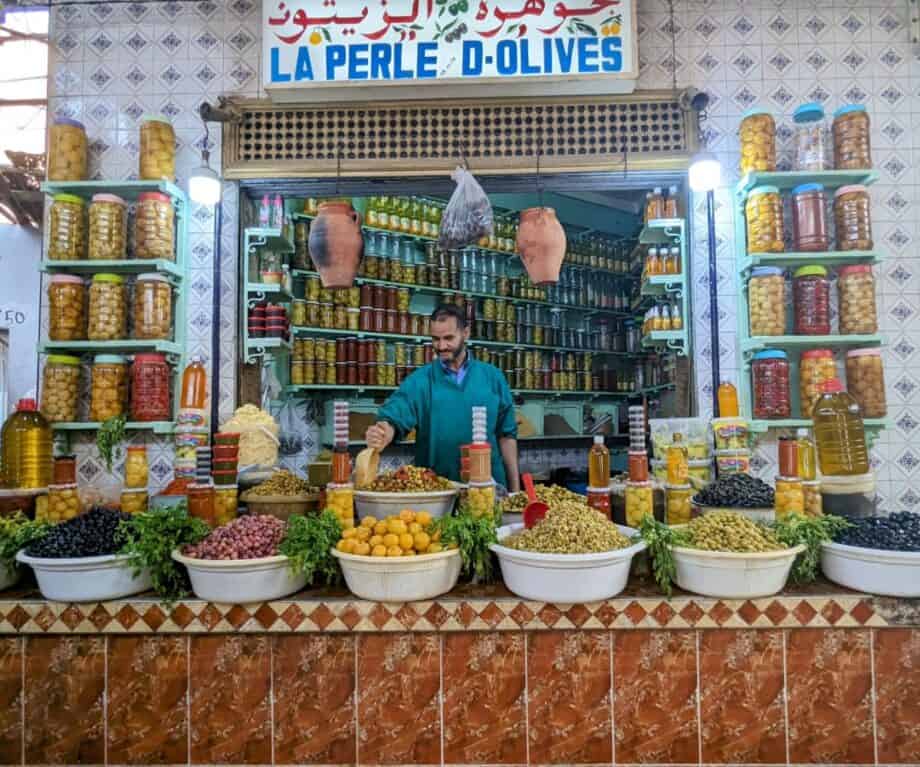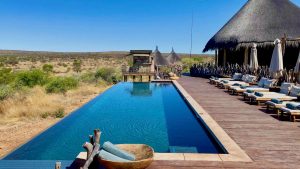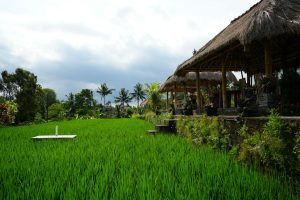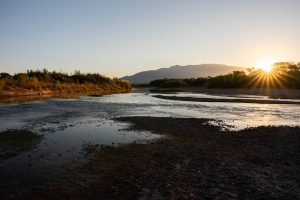
The magic of Morocco radiates from its bustling souks, ancient medinas and fortified kasbahs, to its rugged mountains, rolling deserts and deserted beaches. This is a country of dazzling diversity.
Morocco is a country that’s been influenced by many different cultures. Its proximity to Spain, its occupation by France and the influences of North Africa and the Middle East have all left their mark on the architecture, cuisine, attire, and even the language. The best things to do in Morocco are equally as varied; one day you could be trekking in the Atlas Mountains and the next you could be strolling through the twisting alleyways of Marrakesh, or savouring street food in the medieval medina of Fez. But unless you’re planning on spending months in Morocco, there’s no way you’ll be able to see it all in one visit, and you shouldn’t even try!
While there’s certainly no shortage of things to do, here are some of my favourites.

Fabulous food in Fez
In Fez, Morocco’s oldest imperial city, time seems to stand still. Dating back to the 8th century, the maze-like high-walled medina is the most complete medieval city in the Arab world. Its tangle of more than 9,500 narrow alleyways contain a jumble of souks, riads, artisan workshops, leather tanneries, mosques, and palaces that date back more than 1,000 years. As the oldest of Morocco’s four imperial capitals, it should come as no surprise that the dynamic medina of Fez is a UNESCO World Heritage Site.



Moroccan cuisine is a genuine melting pot. The Amazigh (Berbers), Arabs, Moors, Ottoman Turks and French have all left their culinary mark. One of the best ways to experience Fez is through its food and a food tour here not only lets you munch your way through the delights of Moroccan food, it also gives you an education into the history of the city. Foodies can sample everything from local breads, to tasty tagines, delectable dates, opulent olives, and for the more adventurous, snail soup or boiled sheep’s head. Finish off with that most tempting of sweet treats, chebakia (deep-fried dough coated in sesame seeds) and wild honey.



After your days in the medina, stay at Palais de Fes Dar Tazi, a hotel that dates back to the 14th century and looks out over the medina. The hotel’s rooftop restaurant serves meals that pay homage to the culinary heritage of Morocco, with everything from fabulous tagines to an incredible pigeon pastilla, a delicacy that dates back to the 15th century, made of filo pastry, stuffed with rich, tender pigeon meat, aromatic spices and lightly scrambled egg and finished with a sprinkling of icing sugar and cinnamon.

Marvel at the medina of Marrakech
Marrakech needs no introduction, it’s probably the best-known city in all of Morocco. Located north of the foothills of the Atlas Mountains, the bustling, red city of Marrakesh, named for the beaten clay that gives it its deep reddish tinge, is a sensory overload of sights, sounds and smells.


The ancient medina of Marrakesh is a maze of narrow streets with the Djemaa El Fna, arguably Africa’s most famous square, at its heart. By day, the square is just a big open space, with a handful of snake charmers, monkey wranglers and ‘tooth pullers’, wielding fearsome pliers and offering to pluck out the teeth of any toothache sufferers. It isn’t until late afternoon that the square really gets going.

People come out for an early evening promenade, and the square gradually fills, until it becomes a circus of storytellers, acrobats, musicians and entertainers. (One note of caution – the snakes are often caught from the wild and have their mouths sewn shut and fangs pulled out, and the Barbary macaque monkeys, used as props for tourists, are often taken from their mothers in the wild and hand-reared because they are easier to tame that way. Using wild animals as photo props is illegal in Morocco, but it seems to be tolerated in the square – I’m not a fan.)



For a respite from the square, move to the rooftop terrace restaurants. The fantastic Chez L’Amine Hadj Mustapha is a place synonymous with traditional food, and even TV chef, Gordon Ramsay, says the meat here is cooked to perfection. I’ve never tasted anything comparable to their chunky, big mouthfuls of tender Mechoui or Tangia Marrakechia.

Marrakesh will satisfy even the most insatiable shopaholic. The labyrinthine passageways of the souk are filled with everything from aromatic spices to leather babouches (slippers) and carpets, with artisans weaving, hammering and carving out their wares as they’ve done for centuries. The main thoroughfares, such as Souq Semmarine, are dedicated to tourist trinkets, so wander off the main path to find the best shopping.


For a change of pace, get soaped, scrubbed, steamed and massaged at a hammam (bathhouse). Whether you choose a communal public bath or a private experience in a luxury riad, this traditional therapy of brisk exfoliation and bathing, using natural cleansers, has promoted physical and mental health for centuries. It’s an unforgettable experience and you’ll emerge with the softest skin, for days afterwards.



Marrakesh’s accommodation is an attraction in itself. If possible stay in one of the medina’s riads. A riad is a traditional Moroccan medina mansion, with a courtyard garden in the middle. Many have been restored and opened as luxury hotels, with wood ceilings, tadelakt (polished lime plaster) walls, traditional zellij (ceramic tile) details, and brass swinging lamps. Le Farnatchi is one such place, an amalgam of nine old houses, fashioned into one luxurious riad, right in the heart of the medina, with ten spacious suites, a rooftop terrace, an award-winning hammam and a fantastic rooftop restaurant, Le Trou au Mur, in an adjacent property.

Step back in time in Skoura
The Skoura oasis is located on the southern side of the High Atlas Mountains, about 5 hours drive from Marrakech.

The region is dotted with labyrinthine ksar (fortified villages), including Ait Ben Haddou, a UNESCO World Heritage Site, as well as many imposing mud-brick kasbahs, like the magical ruins of Kasbah Amridil.

Skoura is also an excellent base from which to explore the Dades Valley, the Valley of the Roses, and the Draa Valley.


Skoura’s beautiful Unesco-protected 4,500 hectare palmeraie (palm grove) has been dubbed ‘Oasis of 1000 Palms’, and under the canopy of green, a patchwork of plots is watered by an ingenious, centuries-old khettara (underground irrigation system) of canals, levers and locks. More than 100 bird species flourish here, as well as more than 20 date varieties.




Stay at Dar Ahlam, a 19th-century traditional rammed-earth kasbah in the Skoura palmeraie grove. Dar Ahlam is a haven of manicured lawns and fragrant almond blossoms, and it more than lives up to its Arabic translation of the ‘House of Dreams’. With no check-in or check-out times, amazing dining experiences, with meals crafted from local ingredients, many of which are grown in the hotel’s garden, and an entire team dedicated to making your every wish come true, this desert oasis delivers luxury without limits.

Everything you need to plan your trip in 2024
Hike the High Atlas Mountains
The High Atlas is a hiker’s paradise, running diagonally across the country for 1,000km, from the Atlantic coast to northern Algeria. Imlil, 67km south of Marrakesh is located in the foothills of the High Atlas. It’s the jumping-off point for fantastic trekking, including scaling Toubkal, North Africa’s highest peak (4,167m).


Alternatively, hike between remote, rural Amazigh (Berber) villages, through isolated valleys, on centuries-old trails, and get to know local traditions and history. The High Atlas is the perfect getaway from the hustle and bustle of urban Morocco.

At Imlil stay at Kasbah du Toubkal, the home of a feudal caïd (local baron) transformed into a haven of welcoming Berber hospitalityThe kasbah also has a trekking lodge, a day’s walk away, for those interested in multi-day hiking.



After spending some days ‘roughing’ it in the mountains, there’s nowhere better than Olinto, a luxury retreat in the Ouirgane Valley, to recover and relax. With its backdrop of the High Atlas Mountains and buried deep in an ancient grove of twisted olive trees, Olinto is a retreat like no other. The brainchild of Prince Fabrizio Ruspoli di Poggio Suasa, with only nine private guest pavilions, this is the place for ultra-privacy, peace and discreet luxury. Local flavours and seasonal cooking dominate the menu, with much of the produce coming from the hotel’s gardens, right down to the olive oil, pressed from Olinto’s own trees.

Tantalising Tangier
Tangier is Morocco’s third largest city, and the souk here is over 700 years old. For many Tangier is the gateway to Morocco, given its location at the northern tip of the country and its proximity to Europe. Ferry crossings from Tarifa in Spain only take around 2 hours and flights from the UK are less than 3 hours.


Tangier is a hustling, bustling blend of cultures that has been influenced by many peoples throughout its history. Jews, Muslims, and Christians coexisted here for decades, and Spanish was the common tongue. At the meeting point of two seas, as well as two continents, Tangier’s strategic location has made it a highly sought-after spot since ancient times. Founded by Mediterranean trading nations, ruled by empirical Romans, and squabbled over by European powers, before finally returning to the Moroccan nation in 1956, it’s perhaps no surprise that this city is like no other in the country.


Visit the whitewashed, hillside medina with its higgledy-piggledy maze of narrow streets and small squares. Be sure to visit both the Grand Socco and the Petit Socco markets, 9 April 1947 Square, and the Great Mosque, and after a day of shopping or exploring, what could be better than the golden sand of Tangier’s beaches?



At the end of the day Villa Augustine’s plunge pool is a welcome respite, and the rooftop terrace is the perfect place to gaze out at the distant shores of Spain. Formerly a family home, Villa Augustine is a five-bedroom guest house in the old city, only a five-minute walk from the Kasbah and 10 minutes to the Grand Socco. With stylish interiors, created by interior designer and hotelier Willem Smit, Villa Augustine is a mix of classic Moroccan decor, inviting modern furnishings, quirky personal touches, and all the home-from-home comforts you could wish for.

The Agafay Desert
Most visitors to Morocco know of the Sahara Desert. But if an 8 hour drive from Marrakech is not an option, what do you do for a taste of the desert?

Not that many people seem to know about the Agafay Desert, just 30km from Marrakech. While you won’t find golden, rolling sand dunes here (it’s a stone desert) you absolutely can have a secluded desert experience, complete with a stunning view of the High Atlas Mountains. Camel and horse rides, e-biking, and quad-biking, there are plenty of ways to explore the barren, rocky, lunar-like terrain, and after the sun has gone down enjoy a delicious meal and a spot of star gazing.



Glamping in the Agafay Desert at Inara Camp is a luxurious experience. Terrific ‘tents’ with king-size beds, ensuite bathrooms, air conditioning and panoramic views over the desert. Endless cups of freshly brewed mint tea, a myriad of activities, and some incredible dining experiences. The chef’s slow-cooked lamb tagine was one of the best we ate in Morocco, the picnic lunch that accompanied our camel ride through the desert was delicious and decadent, and a private desert dinner, accompanied by fire eaters, musicians and hena artists was memorable.

Tucked into the Northwest corner of Africa, Morocco’s geographic, cultural, and gastronomical offerings are so incredibly diverse you’d need weeks, months or even years to discover it all. Being so vast and varied, planning a vacation here can feel overwhelming, and this is where Wix Squared comes to the rescue. WIX Squared is a bespoke luxury travel company, whose founder Alex Wix is consistently named by both Condé Nast Traveller and Robb Report as one of their top travel specialists. Alex is currently based in Marrakesh, which gives her that extra insider expertise for planning the perfect Moroccan itinerary.

Did you enjoy this article?
Receive similar content direct to your inbox.
Please enable JavaScript in your browser to submit the form






